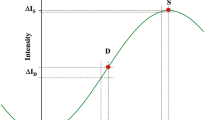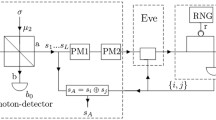Abstract
Phase-matching quantum key distribution (PM-QKD) protocol has been widely researched since it was proposed. This scheme is proven to beat the linear bound. In this paper, the performance of three-intensity decoy-state PM-QKD is discussed. The effects of various parameters on the performance of transmission system with statistical fluctuation and source error are analyzed by numerical simulation. The results show that the protocol has good performance. The effects of signal state intensity and decoy-state intensity on key rate are analyzed, and the optimal key rate and the intensity of signal and decoy states are given.
Graphic abstract







Similar content being viewed by others
Data Availability Statement
This manuscript has no associated data or the data will not be deposited. [Authors’ comment: All data included in this study are available upon request by contact with the corresponding author.]
References
C.H. Bennett, G. Brassard, Theor. Comput. Sci. 560, 7–11 (2014)
N. Gisin et al., Rev. Mod. Phys. 74, 145 (2002)
S.L. Braunstein, S. Pirandola, Phys. Rev. Lett. 108, 130502 (2012)
H.-K. Lo, M. Curty, B. Qi, Phys. Rev. Lett. 108, 130503 (2012)
T. Sasaki, Y. Amamoto, M. Koashi, Nature 509, 475 (2014)
S. Pirandola, R. Laurenza, C. Ottaviani, L. Banchi, Nat. Commun. 8(1), 15043 (2017)
M. Lucamarini, Z.L. Yuan, J.F. Dynes et al., Nature 557, 400–403 (2018)
X.B. Wang, Z.W. Yu, X.L. Hu, Phys. Rev. A 98(6), 062323 (2018)
Z.W. Yu, X.L. Hu, C. Jiang, H. Xu, X.B. Wang, Sci. Rep. 9(1), 3080 (2019)
M. Curty, K. Azuma, H.K. Lo, npj Quantum Inf. 5(1), 64 (2019)
W. Li, L. Wang, S. Zhao, Sci. Rep. 9(1), 15466 (2019)
X. Ma, P. Zeng, H. Zhou, Phys. Rev. X 8(3), 031043 (2018)
P. Zeng, W. Wu, X. Ma, Phys. Rev. Appl. 12, 6 (2020)
X.X. Zhang et al., J. Opt. Soc. Am. B 38, 3 (2021)
Y. Yu et al., Opt. Exp. 29, 2 (2020)
X.B. Wang et al., Phys. Rev. Lett. 94, 230503 (2005)
X.F. Ma, B. Qi, Y. Zhao, H.K. Lo, Phys. Rev. A 72, 012326 (2005)
W.T. Liu, S.H. Sun, L.M. Liang, J.M. Yuan, Phys. Rev. A 83, 042326 (2011)
S. Wang et al., Phys. Rev. A 79(6), 062309 (2009)
X.B. Wang, C.Z. Peng, J. Zhang, L. Yang, J.W. Pan, Phys. Rev. A 77(4), 042311 (2008)
Q. Wang, X.B. Wang, Sci. Rep. 4, 4612 (2014)
C. Jiang, Z.W. Yu, X.B. Wang, Phys. Rev. A 94(6), 062323 (2016)
Q.P. Mao, L. Wang, S.M. Zhao, Quantum Inf. Process. 19, 2 (2019)
X. Ma, C.H.F. Fung, M. Razavi, Phys. Rev. A 86, 052305 (2012)
X.B. Wang, L. Yang, C.Z. Peng, J.W. Pan, New J. Phys. 11(7), 075006 (2009)
D. Gottesman, H.K. Lo, N. Lutkenhaus, J. Preskill, Quantum Inf. Comput. 4, 325 (2004)
Acknowledgements
This work is supported by National Natural Science Foundation of China (Grant No. 61571060), Ministry of Science and Technology of China (Grant No. 2016YFA0301300) and Fundamental Research Funds for the Central Universities (Grant No. 2019XD-A02).
Author information
Authors and Affiliations
Contributions
All of authors contributed to the conception and design of the present work, theoretical framework, numerical calculations, result analysis, drafting of the manuscript and its critical revision.
Corresponding author
Rights and permissions
About this article
Cite this article
Song, Z., Huang, G., Dong, Q. et al. Analysis of three-intensity decoy-state phase-matching quantum key distribution. Eur. Phys. J. D 75, 298 (2021). https://doi.org/10.1140/epjd/s10053-021-00311-4
Received:
Accepted:
Published:
DOI: https://doi.org/10.1140/epjd/s10053-021-00311-4




